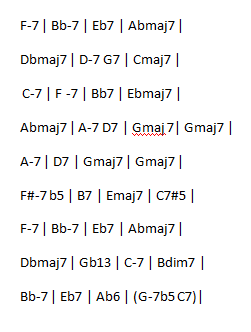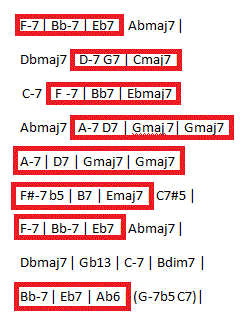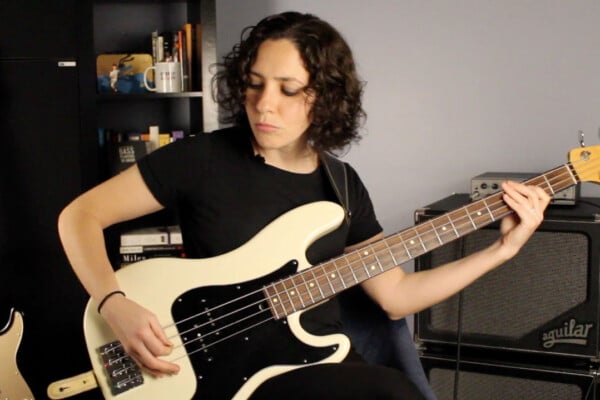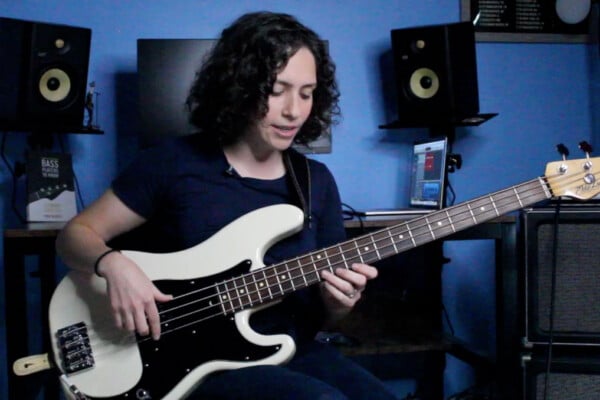Lesson: Pattern Recognition in Jazz Standards
Believe it or not pattern recognition is extremely important to being a successful jazz player. There are a few common chord progressions that will pop up in many tunes – having an arsenal of lines or phrases for these different pattern sets can save your neck on the bandstand if you don’t know the tune. In this lesson we’ll go over a few common patterns and their usage in jazz standards.
The most common pattern is the ii-V-I. This pattern appears in a huge number of standard jazz tunes and is the foundation for many songs. The ii-V-I is made of a minor seventh chord, followed by a dominant seventh chord, resolving to a major seventh chord all in the same key. An example in C-major is:
D-7 | G7 | Cmaj7
The structure for each chord in the progression is based on the different modal scales. For example, the D minor seventh chord (D-7) is built from the D-Dorian scale (that’s playing a scale starting and ending on D with the notes of C-major: D E F G A B C D). Taking every other note we get D F A C – a minor third (D to F), a major fifth (D to A) and a minor seventh (D to C) – hence a D minor seventh. The G dominant seventh is built from the G mixolydian mode (playing a scale starting and ending on G with the notes of C-major: G A B C D E F G). Taking every other note again we get G B D F – a major third, major fifth and minor seventh – this is a G dominant seventh. Finally the C major seventh is built from the C major scale (C D E F G A B C). If we take every other note we get C E G B – a major third, major fifth and major seventh – a C major seventh. The G is the five of C and the D is the two of C, hence a 2-5-1 denoted ii-V-I since the ii is minor, you will often see it as ii-V7-I as well.
This pattern can occur in any key, both major and minor. You will often see the pattern in multiple keys throughout a single tune – just keep an eye out for those chord symbols! Here are the changes from “All The Things You Are” by Jerome Kern, see how many ii-V-I patterns you can find:

Figure 1: Chord changes to “All The Things You Are”
Did you find a few? By my count there are 8 distinct ii-V-I’s plus a few modulations. I’ve outlined the ii-V-I’s in red:

Figure 2: ii-V-I’s Identified
Here is the order of each ii-V-I (by key): Eb, C, Eb, G, G, E, Eb, Ab. This is a much easier way to remember the tune – rather than memorizing each chord you now just need to know the order of the ii-V-I’s with the few intermittent chord changes. There’s another advantage to this: if you have a specific lick or phrase that works over a ii-V-I you can apply it to each key center in the song. Obviously if you played the same thing for each ii-V-I in “All The Things You Are” it would sound really repetitive, but knowing that lick works and knowing how to quickly shift to it can be a great navigational tool for finding your way around a tune.
Another progression to keep your eyes open for is the I-vi-ii-V progression. This is also an incredibly common progression that you’ll find throughout jazz standards. It’ often used as a “turnaround” at the end of a song or as a tag-out line, but can also be inserted other places. The vi-chord is also a minor seventh, based on the sixth mode of the major scale. If we continue in the key of C, this would be the A Aeolian scale (A B C D E F G A) which is a minor third, major fifth and minor seventh – a minor seventh chord. Often you’ll see this harmonized as a dominant seventh chord because those provide a stronger resolution to the ii and have more opportunities for alterations and additional reharmonizations. A similar progression, the III-vi-ii-V, is also seen frequently in turnarounds. In the key of C the I-vi-ii-V progression would be:
Cmaj7 | A-7 | D-7 | G7|
Pick your favorite jazz tunes and analyze them for these progressions, you’ll be amazed at how many times they each appear in different keys throughout the tune.
Once you have these patterns identified the next step is to practice them as a unit so you are never surprised when you have to play them. Think about it – if you become comfortable with the ii-V-I and I-vi-ii-V progressions you’ll already have the chordal guts of lots of jazz standards learned, it will make sight reading a surprise songs much easier to deal with. Additionally your ear will start to pick out these progressions quickly, making it easier to learn new tunes. To practice play through the chord tones in each pattern making melodies without only adjacent tones. For example, if the pattern I’m working on is the ii-V-I in C major, I may play (in any rhythm):
D F F A | B D F G | E C B C |
I’ve restricted myself to only chord tones and only moving to adjacent tones within and across chords. Do this exercise making up as many melodies as you can, vary the number of notes per measure, vary the rhythms, and once you are comfortable start allowing for small jumps and skips. Finally try playing through a tune using your melodies restated in each pattern, or combining different melodies for each key center. In a few weeks of consistent practice you’ll be amazed at the results!




Hi, I think you may have a small error on this page. You highlighted the F-7 Bb-7 Eb7 as the 2 5 1 in two places when it is the
Bbm7 Eb7 Abmaj7.
Steve
The first four bars is VI-II-V-I in the key of Ab. Or take it from the last bar and see it as a II-(b5)-V-I i the key of Fminor. And The messure 21 and 22 is still in the key of Gmajor and can be seen as VII-III in Gmajor or II-(b5)V-I in Eminor,,, the major chord is just a I (Emajor) chord to fitt the melody.
The first four bars is VI-II-V-I in the key of Ab. Or take it from the last bar and see it as a II-(b5)-V-I i the key of Fminor. And The messure 21 and 22 is still in the key of Gmajor and can be seen as VII-III in Gmajor or II-(b5)V-I in Eminor,,, the major chord is just a I (Emajor) chord to fitt the melody.
The first four bars is VI-II-V-I in the key of Ab. Or take it from the last bar and see it as a II-(b5)-V-I i the key of Fminor. And The messure 21 and 22 is still in the key of Gmajor and can be seen as VII-III in Gmajor or II-(b5)V-I in Eminor,,, the major chord is just a I (Emajor) chord to fitt the melody.
The first four bars is VI-II-V-I in the key of Ab. Or take it from the last bar and see it as a II-(b5)-V-I i the key of Fminor. And The messure 21 and 22 is still in the key of Gmajor and can be seen as VII-III in Gmajor or II-(b5)V-I in Eminor,,, the major chord is just a I (Emajor) chord to fitt the melody.
There is a missing bar in All The Things You Are. Should be 36 bars long not 35.